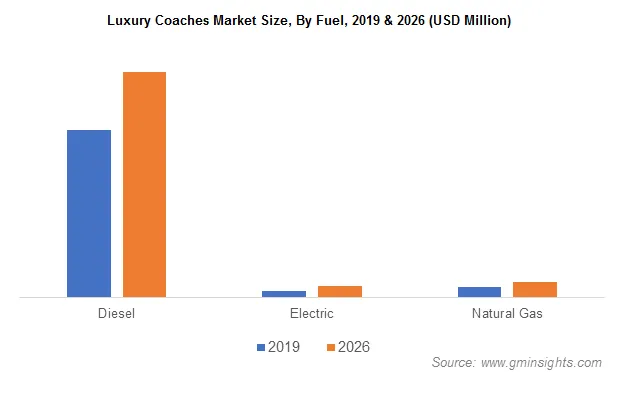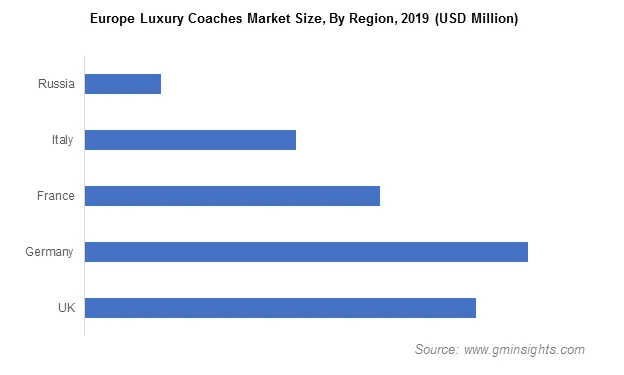Home > Automotive > Railways > Locomotive > Luxury Coaches Market
Luxury Coaches Market Size
Luxury Coaches Market size exceeded USD 31.5 billion in 2019 and is estimated to grow at a CAGR of over 5% between 2020 and 2026. Several advantages offered by luxury coaches, such as reclining berths, advanced entertainment features, and spacious interiors, are contributing to the growing market demand.
Increasing consumer disposable incomes and shifting focus towards comfortable long-distance travel are expected to provide robust growth opportunities for the market. For instance, the U.S. Bureau of Economic Analysis reported a 12.9% increase in the per capita disposable income in 2019. The rise in discretionary spending capabilities is supporting the market growth by encouraging consumers to avail the services of luxury coaches for intercity travel.

The latest industry trend of autonomous vehicles is providing a positive outlook for the luxury coaches market. Advancements in the field of autonomous and driver assistance technologies are being integrated with luxury coaches for enhanced driving experience and improved passenger safety. Market players are launching fully autonomous and semi-autonomous models of luxury coaches in response to the growing market trend.
| Report Attributes | Details |
|---|---|
| Base Year: | 2019 |
| Market Size in 2019: | 31.5 Billion (USD) |
| Forecast Period: | 2020 to 2026 |
| Forecast Period 2020 to 2026 CAGR: | 5% |
| 2026 Value Projection: | 43 Billion (USD) |
| Historical Data for: | 2016 to 2019 |
| No. of Pages: | 220 |
| Tables, Charts & Figures: | 410 |
| Segments covered: | Deck, Fuel |
| Growth Drivers: |
|
| Pitfalls & Challenges: |
|
One of the major industry challenges restricting the luxury coaches industry is the high cost involved with the initial purchase of these buses due to the extensive features offered by them. These coaches are integrated with high-end amenities, such as LED screens, earphones, reclining berths, and on-board toilets, which add to the increasing cost. However, companies, such as Volvo, Daimler, and Scania are offering financing programs with attractive interest rates to encourage sales and support the industry growth.
The rapid spread of the COVID-19 pandemic has adversely impacted the market size of luxury coaches in 2020. The slow growth rate can be attributed to the increasing financial insecurities among large government and industrial buyers. The sharp decline of the travel and tourism industry due to government-imposed movement restrictions and lockdowns has impacted the revenues of private transportation companies. Bus operators are postponing the purchase decisions of new vehicles. The market forecast shows a gradual growth in demand with the revival of tourism.
Luxury Coaches Market Analysis
The single deck luxury coaches segment valued at around USD 27.5 billion in 2019. These coaches offer improved drivability and maneuverability compared to double decker buses due to their short height. High-deck buses are witnessing an escalating market demand for long distance travels as they offer a better view of the surroundings to the passengers.
Single-deck luxury coaches with a seating capacity of 40 – 70 passengers are contributing significantly to the overall market size owing to the enhanced passenger carrying capacity. New product launches in this segment are also positively influencing the market revenues. For instance, in January 2019, Hyundai launched its high-end luxury bus, the Universe 2019 in Vietnam. The luxury coach offers a seating capacity of 47 – 50 passengers.

The electric luxury coaches market is projected to expand at more than 8% CAGR through 2026. Market analysis and trends project a high growth in this segment owing to the implementation of stringent vehicle emission norms introduced by several government authorities across the globe.
Companies operating in the market are launching new models of electric and hybrid electric variants to cater the growing demand.

The Europe luxury coaches market revenue was over USD 8 billion in 2019 and is anticipated to witness 5.5% growth rate from 2020 to 2026. European countries are connected with a robust highway and road network. The region also hosts picturesque landscapes, encouraging tourists to opt for travel by road.
The presence of established coach manufacturers, such as Daimler AG, Volvo Group, and Scania in Europe is further driving the market growth trends. These players are heavily investing in R&D and adopting product innovation strategies to launch new products with enhanced capabilities. For instance, in 2019, Volvo Group invested approximately 4.4% of its total revenues in R&D and innovation activities.
Luxury Coaches Market Share
Industry players are focusing on expanding their manufacturing and R&D operations in international markets to leverage opportunities such as affordable labor and easy access to raw materials. Market leaders are also emphasizing on forming partnerships with regional players to enhance their shares in foreign markets.
Key players operating in the luxury coaches market include :
- Daimler AG
- Scania AB
- Volvo Group
- JCBL Ltd
- Yutong, BYD Group
- Napoleon Bus GmbH
- ANKAI
- Setra
- Marcopolo SA
- Shanghai Shenlong Bus Co., Ltd
- Xiamen King Long Motor Group Co., Ltd
- Irizar Group
This market research report on luxury coaches includes in-depth coverage of the industry with estimates & forecast in terms of revenue in USD and shipment in units from 2020 to 2026 for the following segments:
Click here to Buy Section of this Report
Market, By Deck
- Single Deck
- Seating capacity
- Below 40 seats
- 40 – 70 seats
- Above 70 seats
- Seating capacity
- Double Deck
Market, By Fuel
- Diesel
- Electric/
- Natural gas
The above information has been provided for the following regions and countries:
- North America
- U.S.
- Canada
- Europe
- UK
- Germany
- France
- Italy
- Russia
- Asia Pacific
- China
- India
- Japan
- South Korea
- Latin America
- Brazil
- Mexico
- MEA
- Saudi Arabia
- UAE
- South Africa
Frequently Asked Questions (FAQ) :